
The global authority in superyachting
- NEWSLETTERS
- Yachts Home
- The Superyacht Directory
- Yacht Reports
- Brokerage News
- The largest yachts in the world
- The Register
- Yacht Advice
- Yacht Design
- 12m to 24m yachts
- Monaco Yacht Show
- Builder Directory
- Designer Directory
- Interior Design Directory
- Naval Architect Directory
- Yachts for sale home
- Motor yachts
- Sailing yachts
- Explorer yachts
- Classic yachts
- Sale Broker Directory
- Charter Home
- Yachts for Charter
- Charter Destinations
- Charter Broker Directory
- Destinations Home
- Mediterranean
- South Pacific
- Rest of the World
- Boat Life Home
- Owners' Experiences
- Conservation and Philanthropy
- Interiors Suppliers
- Owners' Club
- Captains' Club
- BOAT Showcase
- BOAT Presents
- Events Home
- World Superyacht Awards
- Superyacht Design Festival
- Design and Innovation Awards
- Young Designer of the Year Award
- Artistry and Craft Awards
- Explorer Yachts Summit
- Ocean Talks
- The Ocean Awards
- BOAT Connect
- Between the bays
- Golf Invitational
- BOATPro Home
- Superyacht Insight
- Global Order Book
- Premium Content
- Product Features
- Testimonials
- Pricing Plan
- Subscriber Login

Yacht classification definitions
The merchant shipping sector is ruled by safety regulations developed since the beginning of the 20th century, and is familiar with international conventions such as SOLAS, MARPOL and Load Lines. But the application of common safety requirements to pleasure vessels is something relatively new – a continuous work in progress – and is very much dependant on the service and the flag of the yacht.
Defining the problems
Definitions do not help. How often have we read of large yachts, superyachts, megayachts, gigayachts or other bombastic adjectives? How many times have we mentioned MCA, RINA, and Lloyd’s, without having a clear idea of who’s doing what?
A good starting point for understanding the subject is to clarify the main definitions and the roles of the main players:
Large yacht
A large yacht is a pleasure vessel with a load line length equal to or over 24m. Almost all the flag administrations have adopted safety codes dedicated to large yachts and this is, therefore, the only definition having a universal meaning in the international regulatory framework of yachts.
Commercial yacht
A motor or sailing vessel in commercial use (i.e. charter) for sport and pleasure, carrying no cargo and not more than 12 passengers.
Private yacht
A pleasure vessel solely used for the recreational and leisure purpose of its owner and his guests.
Flag administration
The government of the state whose flag the yacht is entitled to fly . This administration sets the safety regulations, manning requirements and fiscal aspects relevant to the yacht registration.
Different flag administrations can inspect the safety aspects of yachts with their own inspectors (see MCA for example) or delegate this activity partially or totally to other recognised bodies such as the classification societies.
The main flag authorities in the yachting industry are: The UK-MCA, Cayman Islands, Isle of Man, Malta, the Marshall Islands, Italy and Luxembourg.
Classification societies
Organisations that establish and apply technical standards in relation to the design, construction and survey of ships.
Classification rules are developed to assess the structural strength and integrity of the essential parts of the hull, the reliability and function of the propulsion, steering systems, power generation and all the other features installed on board which contribute to guarantee the main essential services.
In addition to this ‘third party check’ function, class societies carry out statutory duties on behalf of the major flag administrations in accordance with specific delegation agreements signed with each government.
The main class societies involved in yachting are: American Bureau of Shipping, Bureau Veritas, Det Norske Veritas, Germanischer Lloyd, Lloyd’s Register, and RINA.
Large yachts: Applicable rules and certificates
Private yachts
The mandatory requirements for these boats are very light. For the majority of flag states, a registration survey and a tonnage measurement, carried out by an authorised surveyor, are sufficient.
The only mandatory international conventions are those relevant to the marine environment: MARPOL and the Anti-Fouling System Convention.
The International Convention for the Prevention of Pollution from Ships (MARPOL) is intended to eliminate the intentional pollution and to minimise the accidental pollution of the marine environment caused by harmful substances.
The Anti-Fouling System Convention’s purpose is to eliminate the presence of harmful substances for the marine environment contained in anti-fouling paints applied to ships.
Classification
While classification is not mandatory, building and maintaining a private yacht in class is the only evidence that the boat has been designed, constructed and operated in compliance with appropriate technical standards. It is therefore highly desirable, especially in relation to insurance and re-sale purposes.
Commercial yachts
All flag administrations require commercial yachts to be certified in accordance with a specific large yacht safety code.
The most popular of these safety codes, and the first that was developed, is the MCA Large Commercial Yacht Code (LY2) published in 2004. It replaced the Code of Practice for the Safety of Large Commercial Sailing and Motor Vessels (LY1) published in 1997.
LY2 is applied by the Red Ensign Group Flags (UK, Cayman Islands, Isle of Man, Bermuda, Gibraltar, British Virgin Islands, etc.) and is recognised as a reference standard for all the yachting industry.
Other flags have developed similar codes. Luxembourg, Italy, Marshall Islands, Malta, Belize and The Netherlands are some examples.
While introducing a stricter set of rules and regulations compared to private yachts, commercial registration offers yacht owners the possibility of making a profit from the chartering activity of their boats, and allows them to take advantage of all the other benefits of a commercial operation (in particular VAT exemption on the purchase, sale, bunkering, provisions, dry-docking, and others).
Mandatory certificates
The number and type of the mandatory certificates depends on the size of the vessel; the following is an indicative list:
- International Tonnage Certificate : A measurement of the internal volumes of the yacht expressed in gross tons (GT). This measurement should not be confused with displacement tonnage, which quantifies the weight of a vessel.
- Large Yacht Code Certificate : Covers life-saving appliances, fire protection and means of escape, navigational and signalling equipment, intact and damaged stability, manning and crew accommodation.
- Class Certificate : This mainly deals with the yacht’s hull, machinery, electrical equipment and outfitting.
- International Load Line Certificate : This certifies the weather-tightness of the yacht.
- Safety Radio Certificate : This is applicable if gross tonnage exceeds 300GT This concerns the radio communication and distress installations.
- MARPOL Annex I Certificate : This is applicable if gross tonnage exceeds 400GT This deals with the disposal of oil and bilge water from machinery spaces.
- MARPOL Annex IV Certificate : This is applicable if gross tonnage exceeds 400 or the yacht is certified to carry over 15 persons. This deals with the disposal of sewage from ships.
- MARPOL Annex V : This is applicable to all ships. It covers the disposal of rubbish.
- MARPOL Annex VI : This is applicable if gross tonnage exceeds 400GT as well as to all main and auxiliary engines with a power exceeding 130kW. It concerns the emissions from main and auxiliary engines (NOx and SOx).
- Safety Construction and Safety Equipment : These are additional prescriptions on machinery, electrical parts, life-saving and navigational equipment for yachts with a gross tonnage above 500GT.
- International Safety Management Certificate : This is only applicable to yachts having a gross tonnage greater than 500GT. A certified management company is requested to carry out this service, preparing operational manuals, procedures for drills, and taking care of the maintenance of the yacht and its installations.
- International Ship and Port Security Certificate : This is only applicable to yachts having a gross tonnage greater than 500GT and deals with the anti-piracy certification. A certified management company is requested to provide the ashore assistance and establish on-board procedures and operational manuals.
The GT Factor
The gross tonnage value (GT) is a key issue, not only as a reference for the registration fees applied by the different flag administrations, but also because it determines whether an international convention, rather than a particular safety standard, applies to a yacht.
The table below summarises how the conventions and relevant certificates come into force depending on the gross tonnage of the yacht. In particular, the following values may have a critical impact:
300GT: In many codes, when you reach this value the yacht must be certified in unrestricted service (stricter requirements regarding stability, load line and life-saving appliances).
400GT: This is the threshold for almost all the environmental conventions such as MARPOL and Anti-fouling System.
500GT: This is the threshold for the application of the SOLAS Convention, meaning stricter requirements on machinery, safety systems, materials of construction, fire protection, life-saving appliances and navigational equipment. Furthermore an external certified management company is requested for the ISM and ISPS certifications.
The tonnage issue could also arise on existing yachts when undertaking major refits or modifications, in that any change to the internal volumes of the boat – such as adding enclosed deckhouses or superstructures, or modifying the hull transom or bow – will modify the tonnage value with the risk of subjecting the yacht to stricter mandatory rules.
UPDATE: Since this article was originally published, LY2 has been superseded by Large Commercial Yacht Code Revision 3 (LY3) .
Sign up to BOAT Briefing email
Latest news, brokerage headlines and yacht exclusives, every weekday
By signing up for BOAT newsletters, you agree to our Terms of Use and our Privacy Policy .
More stories
Most popular, from our partners, sponsored listings.
Ita Yachts Canada
Brokerage / Courtage
Demystifying yacht classification A, B, C, D
N.B. For your information, a more recent article was published on 24 Oct 2022 on the same subject, click here for direct access.

Demystifying yacht classification : Class A, B, C and D
Since 1998, CE certification is required for all recreational boats entering or being sold in Europe obliging boat manufacturers to respect certain building and security standards. Therefore, yachts ( boats ) are classified into four categories depending on their aptitude to confront navigational conditions taking into account both force of the wind and height of the waves. The categories are not to limit the area and distance of navigation (that is defined by security equipement onboard) but to sensitize the owner and/or captain of the boats capacities to navigate in complete security.
Let us start with the Beaufort Scale. A scale for classifying the force of the wind ranging from 0 (calm) to 12 (hurricane). It was devised by an admiral in the British Navy, Francis Beaufort, to uniform the description of the effect of different winds at sea.
There is a direct link between the Beaufort scale and boat classification. For discussion purposes, we will use only the 6, 7 and 8 forces.
A Class A yacht ( boat ) is a vessel that is built to navigate the open ocean and surpass a force 8 on the Beaufort scale and surpass waves higher that 4 meters. These yachts are constructed to be self sufficient in hostile seas.
A Class B yacht ( boat ) is a vessel built to navigate on the offshore waters (200 miles and less) and can substain UP TO force 8 and waves UP TO 4 meters.
A Class C boat is a vessel built to navigate inshore such as lakes, rivers, bays and close to the shore and can sustain UP TO force 6 and waves UP TO 2 meters.
A Class D boat is built for protected or sheltered waters such as canals, rivers, small lakes and sustain a force 4 and waves UP TO .3 meters (less that 1 ft).
With this said, you can understand that the Class A yacht ( boat ) respects a rigorous building code more so than a Class B and so forth. But regardless of the class, it is strongly discouraged to navigate in a force 7 for the reasons of safety and comfort as « pleasure » should always be on the agenda. Always consult the weather forecast prior to leaving any port and check hourly the weather situation.
Classification is very important and should be on your question list before purchasing any boat or yacht.
Classification rules are developed to assess the structural strength and integrity of the essential parts of the hull, the reliability and function of the propulsion, steering systems, power generation and all the other features installed on board which contribute to guarantee the main essential services of yacht.
Also for a class A, the portholes will be more resistant against a sustained wave, the drains to evacuate the water more abundant and of good size, the joints of the hull more hermetic, in short everything is in place to prevent water from s’ infiltrate on board.
By way of information, let us quote for example all the Ferretti yachts (60 to 96 feet), Pershing (60 to 115), the Riva (44 to 122) are all of class A just like the Magellano range at Azimut including also the 66 Flybridge.
Ferretti yachts (500, 550, 670 fly and over), Pershing (7X and over), Azimut Yachts (62, 64, 66, 68 Fly and over, the Sport Series 7X and over, all Magellano) are Class A. There are also other classifications such as RINA and American Bureau of Shipping, Bureau Veritas, Det Norske Veritas, Germanischer Lloyd, Lloyd Register, that are more precise regulations and we will cover this later in another article.
Below is the graph of the Beaufort Scale along with photos.
Do not hesitate to contact us for any additional information, team Ita Yachts Canada is at your disposal.

Share this:
Published by Guy Bolduc
View all posts by Guy Bolduc
Leave a Reply Cancel reply
Discover more from ita yachts canada.
Subscribe now to keep reading and get access to the full archive.
Type your email…
Continue reading
- CATAMARAN MOTEUR
- CATAMARAN VOILE
- CENTER CONSOLE
- FISHING BOAT
- SPORT BRIDGE
- ABSOLUTE YACHTS
- CRUISERS YACHTS
- FOUNTAINE PAJOT
- GRAND BANKS
- KADEY-KROGEN
- MOCHI CRAFT
- MINIGHT EXPRESS
- MONTE CARLO
- NORTHERN MARINE
- OCEAN ALEXANDER
- OUTBACK YATCHS
- PARDO YACHTS
- PRESTIGE YACHTS
- SILENT YACHTS
- $1,5 M to $2,9 M
- $3,0 M to $4,9 M
- $5,0 M to $6,9 M
- $7,0 M to $9,9 M
- $10,0 M and more
- UNDER 49 FEET
- 50 to 59 FEET
- 60 to 69 FEET
- 70 to 79 FEET
- 80 to 89 FEET
- 90 to 99 FEET
- MORE THAN 100 FEET
- CENTRAL AMERICA
- PERSIAN GULF
- UNITED-STATES OF AMERICA
- YACHTS REGISTERED UPDATED
- VIRTUAL TOUR 3D
- YACHTS FOR SALE
- IMPORT-EXPORT
- BLOGUES, NOUVELLES ET CONSEILS
- PODCAST VIDEO
- Pontoon Boats
- Personal Watercraft
- nauticalknowhow
- Nautical Knots
- Tools and Calculators
What are the Different Classes of Boats?
Classes of boats and types of boats are two different things. Every type of boat fits into one of four classes of boats. While a type of boat can vary significantly in appearance and function, class is easy to understand. Boat classes are all determined by the overall length of the vessel.
The class of a boat is significant for you as a boat owner. Boats classes are required to meet certain safety guidelines based on those classes. The size of your boat determines what you need to keep on board. Let’s take a look at the different classes of boats. We’ll also get into different types of boats and see where they fit in terms of class.
Class A Boats
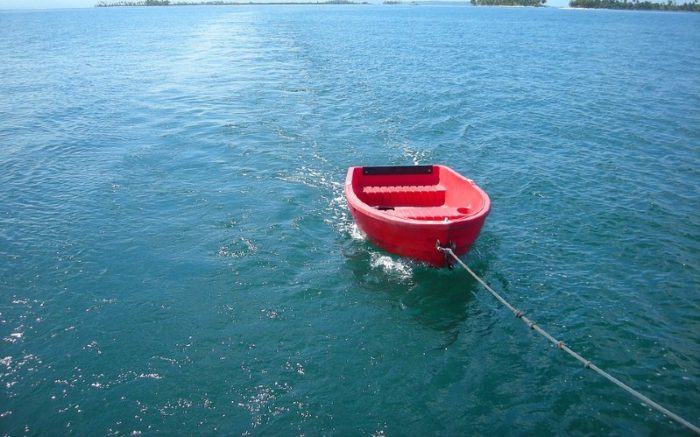
Any boat that clocks in at under 16 feet in length. That means it could be:
- a fishing boat
- A personal watercraft
- An inflatable boat
Recreational boats that are less than 16 feet in length are not required to carry any day signals on board. That said, there are safety requirements. These are regulated by the US Coast Guard. It’s also worth noting that these regulations are slightly different for canoes and kayaks.
Canoes/Kayaks Under 16 Feet
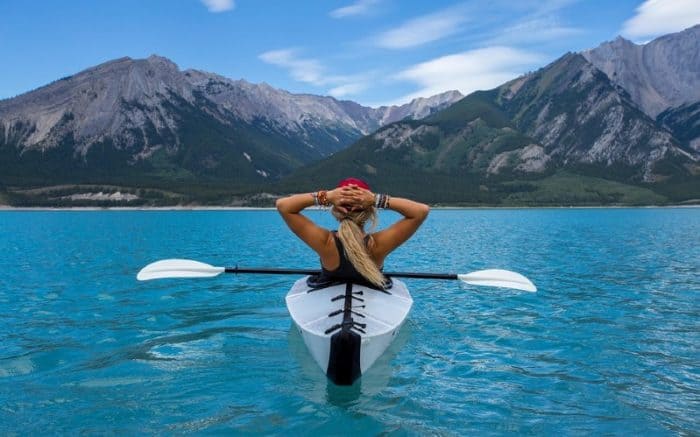
For these vessels, a Type I, II, III or V personal flotation device must be available for every person on board. These need to be US Coast Guard approved flotation devices. They need to be the right size and wearable by the person who plans to wear them as well. If the person is not wearing it, it needs to be someplace they can reach it easily. We recommend anyone on a boat of this size keep their flotation device on at all times. The minimum requirement is that one be available and easy to reach. In an emergency, you can save yourself precious time by having it on already. This is especially true for children on boats.
Visual distress signals are required on the vessel if it’s being operated at night. Your night signal has to be made within the last 42 months as well.
Sound devices are required as well. A whistle is recommended but a horn will work also.
Other Boats Under 16 Feet
All boats under 16 feet require the same personal flotation devices. The rules for a kayak or canoe apply here as well. One for everyone on board that is accessible and wearable. A distress signal is also required for these boats. Sound signals are the same as for kayaks and canoes as well.
There are additional requirements for these kinds of boats if they meet certain conditions.
A B-1 fire extinguisher of any type must be on board any vessel under 16 feet besides a canoe or kayak. That is, if it has an enclosed engine, enclosed living space, or a permanent fuel tank.
A type I, II, or III Marine Sanitation device is required if the vessel has an installed toilet.
A backfire flame arrestor is required if the vessel has a gasoline-powered engine. The exception is if it is an outboard motor.
Enclosed engines must also have ventilation that meets Coast Guard standards.
Class I Boats
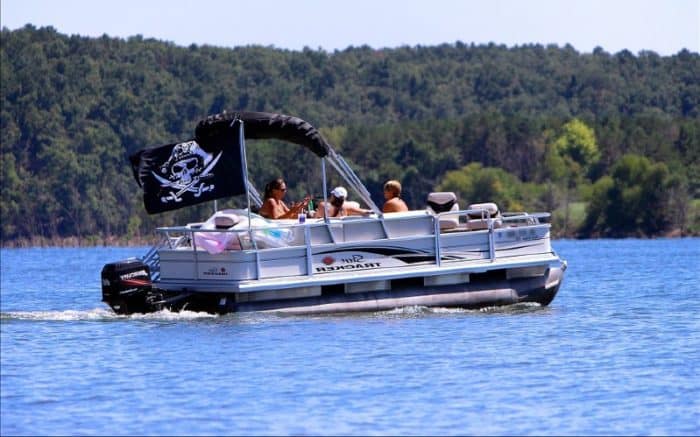
Boats that are between 16 feet and 26 feet fall under this classification. Any number of boats could fall into this class.
- Smaller deck boats
- Cuddy cabin boats
- Pontoon boats
- Aluminum fishing boats
- Wakeboard boats
All Class I boats must have one personal flotation device of Type I, I, III or V per person on board. In addition, one throwable Type IV device is required to be on board. Often people overlook these on tow sports boats. They will only think of the person looking for a thrilling ride water skiing as the one who needs a PFD. The Coast Guard requires them for everyone, however.
A B-1 fire extinguisher of any type is also required to be on board. This is true, again, if the engine is enclosed. It’s not required for outboard motor boats. However, as before, if there is an enclosed living space or permanent fuel tank, then you do need a fire extinguisher.
This size of boat requires specific distress signals. You need a minimum of three day use and night use flares. You can also have a non-flare substitute for day use in the form of an orange distress flag. A Non-pyrotechnic substitute for night use is an electric SOS light. Flares must have been made within the last 42 months.
A horn or whistle is needed as a sound signal.
Class II Boats
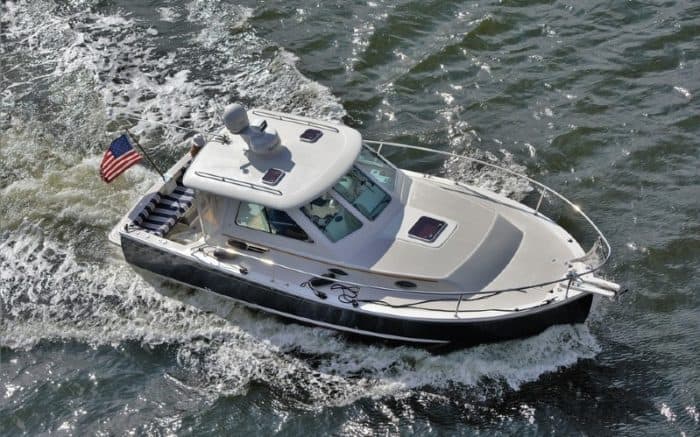
Class II boats are any vessel that span 26 feet to 40 feet. This can include
- Cabin cruisers
- Bowrider boats
- Trawler boats
- Runabout boats
These boats meet the same requirements for PFDs as Class I boats. That means every single passenger on board needs to have access to their own life jacket or other PFD. The acceptable types are Type I, II, III and V. And again a throwable Type IV is also required. These recreational boats can easily hold over one dozen people. Even if you’re freshwater fishing in shallow waters, these requirements must be met.
At this size, either one B-II fire extinguisher or two B-Is are needed. Remember, marine plywood isn’t able to stand up to fire well at all. The extra extinguishers could be a lifesaver at this size of a boat. Nothing ruins some relaxed cruising faster than a boat fire.
Visual distress signals on this kind of boat are the same as those for Class I boats. That means three day use and three night use. Three combination day and night use signals are also acceptable. These are essential for any overnight trips on the boat. Even high performance boats can run into troubles in the dark. Make sure any signal flares have been manufactured within the last 42 months.
Sound devices must be present as with lower boat classes.
Enclosed engines must also have ventilation that meets Coast Guard standards
This class of boat is also required to have pollution regulation placards. Your boat will need a 5″ x 8″ Oil Discharge placard and 4″ x 9″ Waste Discharge placard.
Class III Boats
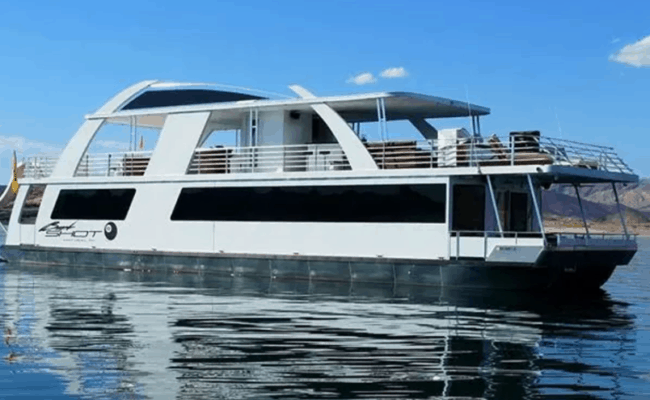
These boats range from 40 feet to no more than 65 feet in length. This can include
- Cigarette boats
- Sport fishers
These are the largest class of boat available to typical boat owners. For these, the same flotation device standards apply as they did for Class II. That means one PFD of Class I, II, III or V is required for every passenger on board. Since different types of boats can carry passengers in greater numbers, this needs to be respected. Make sure every single person knows where the PFD is and how to wear it. Each person must have one that fits properly.
In terms of fire extinguishers, the rules change again with Class III boats. You will need one B-II extinguisher and one B-I extinguisher on board. Alternatively, you could have three B-I extinguishers handy.
Visual distress signals and sound signals are the same as the requirements for smaller class boats. That means three day use and three night use signals. An orange signal flag may substitute one of the day use flares, and an electric SOS light can substitute for one of the night use. A horn or whistle is also required.
This class of boat is also required to have pollution regulation placards. Your boat will need a 5″ x 8″ Oil Discharge placard and 4″ x 9″ Waste Discharge placard. If the vessel has a galley then it must also have a waste management plan.
At this length, the boat must also have the Inland Navigation Rules on board. This is the “Rules of the Road” that govern boating.
Boats Over 65 Feet
Some yachts and things like a ferry boat can easily be over 65 feet. These no longer qualify as subject to small boat regulations. Typically no one is going to own a personal watercraft of this size. The Coast Guard does have regulations in place if you are on a large vessel such as this, however. These apply to vessels from 65 feet up to 165 feet. After that, vessels are typically considered research, commercial, or military.
The rules regarding flotation devices remain static here. One Type I, II, III or V PFD for every passenger on board. In addition, one Type IV throwable device. It’s worth noting there that the “Type” system will not be around forever. The Newton system is slowly being phased on. Newtons measure pounds of force and help indicate how much a PFD can keep afloat. This buoyancy rating in Newtons has been in place since 2019. The transfer is going slowly to allow people time to adjust. Most PFDs you purchase now will explain buoyancy in Newtons.
For instance, a Type II flotation device is equivalent to a current PFD that is rated for 70 Newtons. This device should be able to keep most people floating face up in the water. Type III devices will be replaced with 70 Newton rated PFDs that do not turn you face up. Each device has a Newton rating plus icons. These explain how much weight the PFD is meant to keep you afloat and how it floats you. In several years time, all PFDs will follow these guidelines. That said, old PFDs are still perfectly legal and usable.
For fire extinguishers, weight becomes a factor at this size. Vessels that weigh up to 50 gross tons need one B-II extinguisher. Over 50 gross tons requires two B-II extinguishers on board.
Visual and sound signals are the same for the previous class of vessels. This class does have a variation in sanitation requirements, however. A Type II or Type III marine sanitation device is required for this size of a vessel.
Additional requirements are the same as for the previous class. This includes sanitation and ventilation. The backfire flame arrestor must meet the same requirements as well. A copy of the inland navigation rules must also be on board the boat at all times, also.
What Class are Fishing Boats?
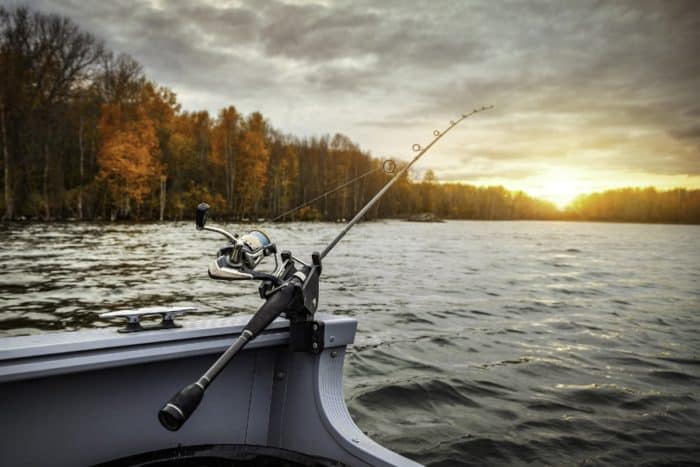
There are dozens and dozens of kinds of boats in the world. You have banana boats, log boats, bass boats and so many more. That’s why the class system is broken down by length. It makes it much easier to categorize a boat in these simple terms rather than trying to manage each type individually.
As a result, something like a fishing boat does not necessarily fit into one class. Your fishing boat could easily fit into literally any one of these classes. Remember, a fishing boat is not even technically a specific kind of boat. A fishing boat is just a boat from which you go fishing. A pontoon boat or some high performance boat could be a fishing boat. An inflatable dinghy could be a fishing boat. There is no standard for that particular description of a boat.
Does a Fishing Boat Need All The Same Safety Gear?
Some people question the application of safety standards. A Class I boat that only has one person on board seems different than one with ten people on board. But the rules are adaptable. If you are the only passenger on the boat then you only need one flotation device. You only need the fire extinguisher if your boat meets the requirements for it. That means something other than an outboard motor.
Man powered boats do not require the same level of safety and concern that power boats do. That’s why canoes and kayaks are exempt from requiring a fire extinguisher. After all, what would be the point? But just because your boat doesn’t have a swim platform or whatever doesn’t matter. Smaller boats or bigger boats all have the same potential to get into trouble. These rules are meant to help prevent that as much as possible. What About Pontoon Boats and Deck Boats?
No matter what kind of boat you’re on, the Coast Guard requirements apply evenly. Again, this can sometimes seem unnecessary. Something like a ski boat may seem more dangerous than cruising around on a deck boat. If you’re just relaxing on inland waters trying to catch largemouth bass, it can seem like overkill. But these measures are designed to ensure safety. In fact, these are the minimum requirements that the Coast Guard has implemented.
Some boaters prefer to have additional measures in place. For instance, as we said above, we recommend wearing a PFD at all times. This is not specifically required, only that the PFD be wearable and accessible. We feel that, the more people on board a boat, the more important it is to make sure everyone is wearing a PFD. This can cut down on wasted time and confusion if an accident happens later. If everyone scrambles for a PFD at the same time, a bad situation could easily become worse.
The Bottom Line
Boat classification has no effect on how you enjoy your boat. It also doesn’t change what you are allowed to do on your boat. The only purpose of classifications is to account for safety on board. Larger boats need to take more care in keeping the boat and passengers safe. Understanding the requirement is key to ensuring the safety of everyone on the water. Make sure you know the full dimensions of any boat you plan to take out onto the water. Once you are aware, you should always do a pre-departure check of the boat.
It’s important to know if you have all the safety gear every time you head out. Make sure the personal flotation devices are all in good working order. Check the date on all flares or visual signals to make sure they meet requirements. Also, check the date on your fire extinguishers before heading out as well. Old gear should be replaced immediately. It’s better to have it and not need it than to need it and not have it.
Keep yourself and your passengers safe and you’ll be having a great time on the water.
My grandfather first took me fishing when I was too young to actually hold up a rod on my own. As an avid camper, hiker, and nature enthusiast I'm always looking for a new adventure.
Categories : Boats
Leave a Reply Cancel reply
Your email address will not be published. Required fields are marked *
Save my name, email, and website in this browser for the next time I comment.
More in Boats

What Is A Gunwale?

131 of the Best Hawaiian Boat Names

167 Patriotic Boat Names

The 138 Best Boat Names for Dog Lovers

The People’s Poncho Review and Ratings

Oru Lake Kayak Review

About Boatsafe
Established in 1998, BoatSafe is your independent guide into the world of boating, fishing, and watersports. We provide expert insights and detailed guides to help you find products tailored to your needs and budget.
Contact Boatsafe
- Address: 4021 West Walnut Street. Rogers, AR 72756
- Phone: (479)339-4795
- Email: [email protected]
Site Navigation
- How We Test
- Corrections Policy
- Privacy Policy
- Terms & Conditions
- Editorial Policy
- Affiliate Disclosure
Our Reviews

All content is © Copyright 2024. All rights reserved.
10% OFF WITH CODE:
BLACKFRIDAY10

- Pre-paid code

- Buy a Gift Card
Boat Sizes: Chart, Classifications and Length
To operate a boat safely and legally, you need to have the right type of safety equipment on board at all times. But how can you know what type of equipment is required for your specific type of boat?
The key is discovering your boat’s class .
And boat classes are determined by boat length .
Let’s take a look at the four different classes of recreational boats, so that you can be prepared when you take to the water.
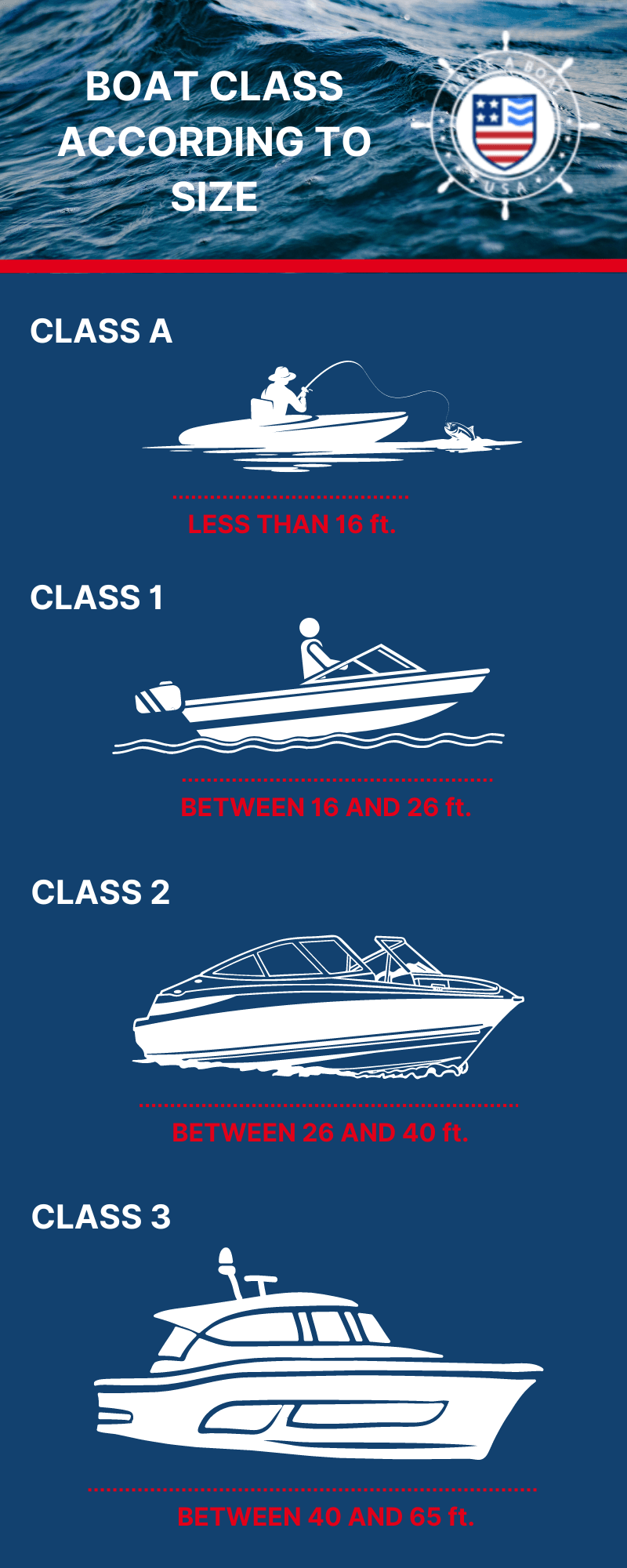
How to measure your boat
You can measure your boat along its centre line from bow to stern, not including any extra attachments like swim platforms. Check out our page outlining the parts of a boat to help you make an accurate measurement.
Class A: Boats measuring less than 16 feet
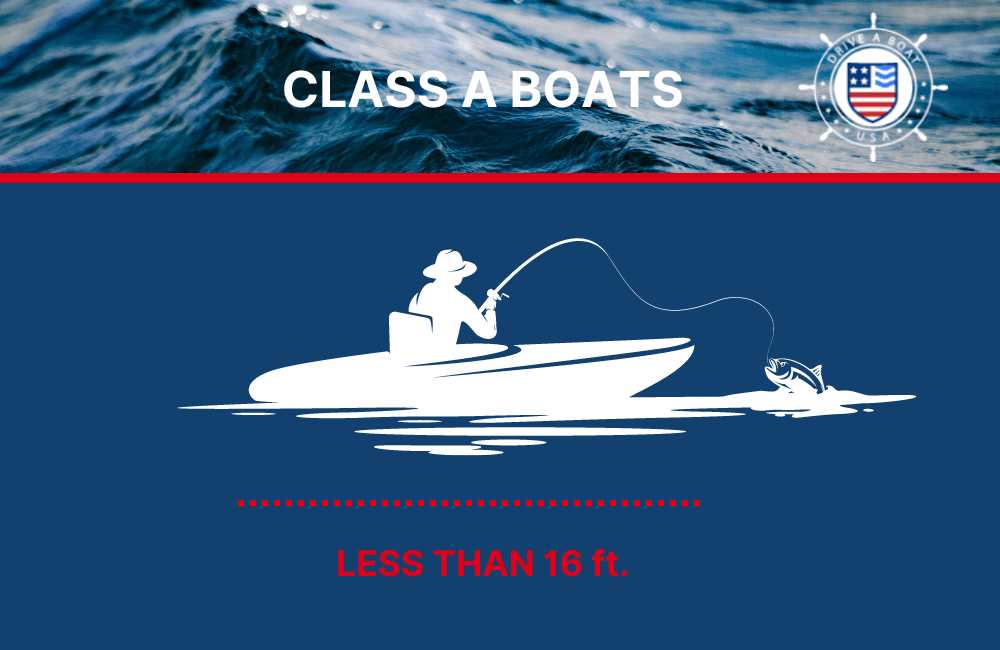
This class includes small fishing boats, canoes, dinghies, personal watercraft and rowboats. To operate this class of boat safely, you need to have:
- Personal flotation devices (PFD) for each person on board or being towed on water skis, etc.
- A bell or whistle
- Visual distress signals (for certain bodies of water) for night-time use
- A fire extinguisher (depending on several factors)
- Ventilation
- A back-fire flame arrestor
Class 1: Boats measuring between 16 and 26 feet

This class includes pontoon boats, jet boats, aluminum fishing boats, smaller deck boats and ski boats. To operate this class of boat safely, you need to have:
- One approved Type I, II or III personal flotation device (PFD) for each person on board or being towed on water skis, etc. and one throwable Type IV device
- Visual distress signals for day and night-time use
Class 2: Boats measuring between 26 and 40 feet
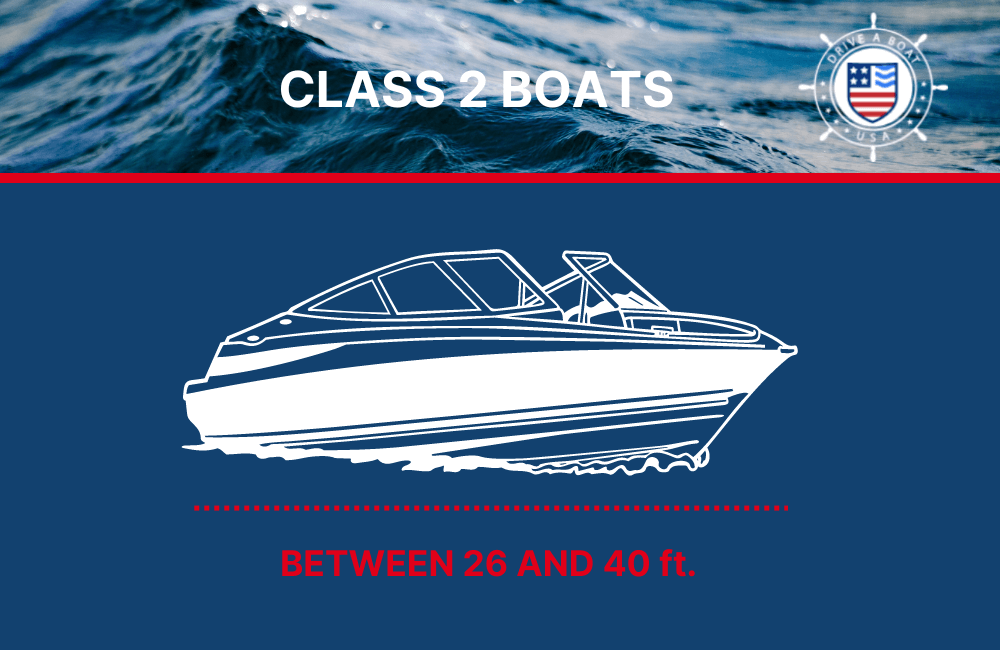
This class includes cabin cruisers, trawlers, sail boats, bowriders and runabouts. To operate this class of boat safely, you need to have:
- A bell or whistle that is audible for 1 nautical mile
- 2 fire extinguishers
Class 3: Boats measuring between 40 and 65 feet
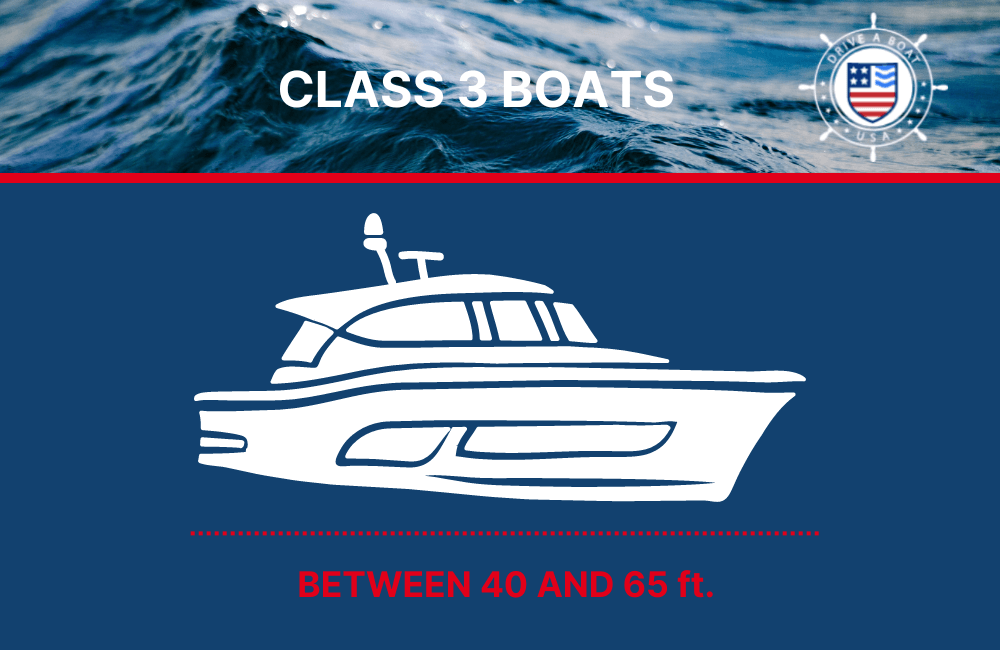
This class includes yachts, sport fishers, catamarans, sail boats and go-fast boats. To operate this class of boat safely, you need to have:
- 3 fire extinguishers
Remember that there could be some variations in the specific type of equipment you need, even within these categories. The best way to be certain that you are prepared to go out on the water is to get your official online state approved boating license .
Learn how to equip your boat with Drive a Boat USA
Whether your boat falls into Class A, 1, 2, or 3, you are responsible for keeping the right safety equipment on board at all times.
Learn what you need to know to enjoy safe and successful boating adventures, including how to drive a boat , from Drive A Boat USA.
Contact us today to earn your official state-approved boating license and take to the water!
- USA Boating
Latest Posts
- State Boater Education Card Courses: Your Questions Answered
- How Much Does a Boating License Cost in New York?
- Florida Boater Education Card: The Complete Guide
- California Boater Card: Everything You Need to Know
- Boating Buoys and Markers: Red & Green Buoy Meanings
- October 2024
- September 2024
- August 2024
- February 2024
- December 2023
- October 2023
- September 2023
- January 2023
- November 2022
- Get certified now
- Replacement California Boater Card
Your browser is out-of-date! You must upgrade to a different browser to experience this site.
All Chapters
- Boating Terminology
- Boat Hull Types & Designs
- Boat Engine Types Explained
- Boat Size Classifications
Boat Capacity
- Hull Identification Numbers
- Boat Registration & Titling
- Life Jacket Types & Designs
- Children's Life Jacket Recommendations & Requirements
- PFD Rules & Requirements
- Life Jacket Fitting & Care Guidelines
- Inflatable PFD Types & Tip
- Boat Fire Extinguishers
- Boat Backfire Flame Arrestor
- Boat Ventilation Systems
- Boat Navigation Light Types & Requirements
- Unpowered Boat Navigation Lights
- Visual Distress Signals
- Marine Distress Signals
- Weather Conditions
- Small Craft Advisory
- Boat Maintenance Tips
- Towing & Trailering
- Launching & Retrieving
- Pre-departure Checklist
- Rendering Assistance
- Capsizing/Falls Overboard
- Cold Water Immersion
- Fire Prevention
- Running Aground Prevention
- Accident Reports
This site requires JavaScript. Your browser either doesn’t support JavaScript or you have it turned off.
For this page to function correctly, please enable JavaScript and then refresh the page.
Boat Size Classifications & Requirements
Boat Classes By Length
Federal and state law requires that you have specific safety equipment on board depending on the class of your boat. To know whether you need flares, a fire extinguisher, a flashlight, an air horn or all of the above, you'll need to know the boat's class. Boat classes are determined by boat length. Let's review the four different classes of recreational boats as determined by length.
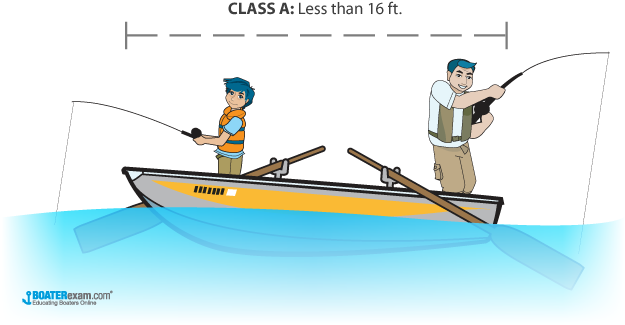
Boats measuring less than 16 feet.
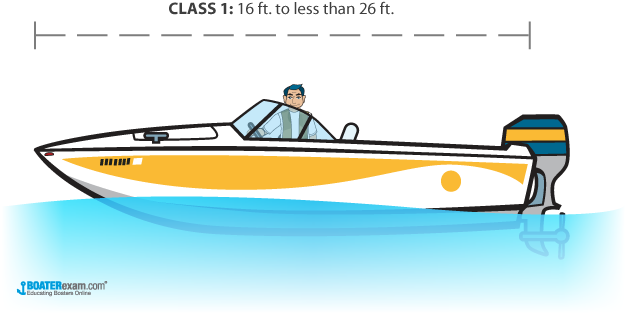
Boats measuring more than 16 feet but less than 26 feet.
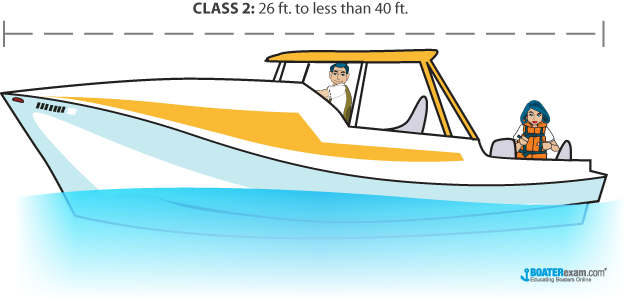
Boats measuring more than 26 feet but less than 40 feet.
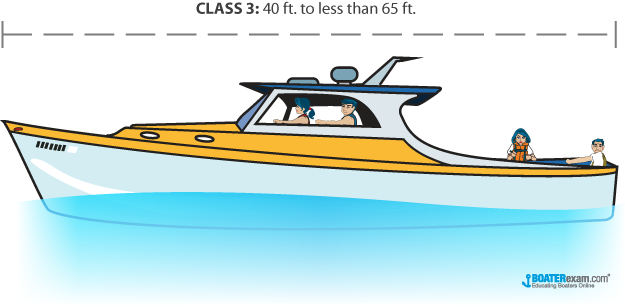
Boats measuring more than 40 feet but less than 65 feet.
How To Determine a Boat's Size
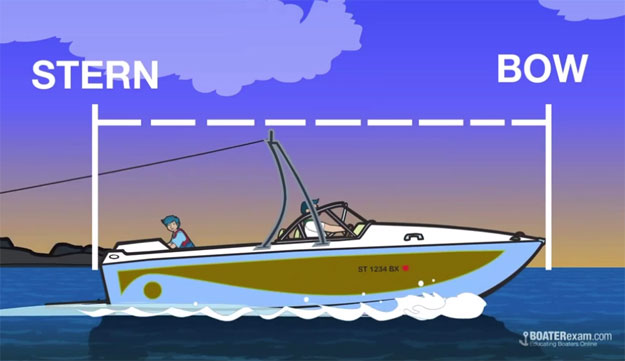
To find out a boat's length, measure along its center line from the outside of the bow to the outside of the stern. That means any attachments, such as swim platforms or wakeboard towers, don't count towards its length.
Boat Engine Types

Save up to 50% on boat storage
- Boat Buying
The 4 Classes of Boats: A Complete Overview
Have you ever wondered what class your boat was in? Or what class was the best for you to purchase? There are four different classes of boats, which are [primarily] broken down by the vessel length.
The class of boat you own and operate will determine the federal and state laws, racing regulations, and safety guidelines you must adhere to.
Let’s explore the four classes of boats and their characteristics.
Understanding Boat Classes
The differences between some boat classes may seem subtle (just a few feet ). However, there is more to boat classification than just length. We’ll examine the variety of boat classes, from Class A to Class 3, and their respective safety requirements.
Class A Boats: Under 16 Feet
Class A boats, such as dinghy boats, are the smallest vessels , measuring less than 16 feet long.
These boats are ideal for calm waters and are often used for relaxed sailing and fishing ventures.
When it comes to safety requirements, all vessels under 16 feet, including jet boats, must carry personal flotation devices and a distress signal. A boat needs a fire extinguisher if it has an enclosed engine, living space, or a permanent fuel tank.
For canoes and kayaks under 16 feet, a whistle or horn is recommended as a sound device.
Class 1 Boats: 16-Less Than 26 Feet
All Class 1 boats measure between 16 and less than 26 feet in length . The Class 1 boats are suitable for both inland and coastal waters and are often used for sports fishing and relaxed cruising.
The Class 1 boat is a popular size for a first boat because of its overall pricing, maneuverability, and versatility.
Safety requirements for Class 1 boats include ventilation that complies with Coast Guard standards for enclosed engines. A backfire flame arrestor is also required.
Class 2 Boats: 26- Less Than 40 Feet
Class 2 boats are larger vessels, spanning between 26 and 40 feet in length .
As for safety requirements, life jackets or other personal flotation devices, such as Type I, II, III, or V flotation devices , must be available for every passenger.
A throwable Type IV device is also a necessity.
Additionally, boats in this class must possess a 5” x 8” Oil Discharge placard and a 4” x 9” Waste Discharge placard to comply with pollution regulations.
Class 3 Boats: 40- Less Than 65 Feet
The largest category, Class 3 boats, vary in size from 40 to 65 feet in length.
Safety equipment requirements demand that Class 3 boats owners have the following onboard: a Type II or Type III marine sanitation device , a horn or whistle, and three-day use and three-night-use signals.
Class 3 boats must have either one B-II extinguisher and one B-I extinguisher or three B-I extinguishers.
Additionally, one Type I, II, III, or V PFD ( Personal Flotation Devices ) must be present for every passenger on board, along with one Type IV throwable device.
Boats in this class must also possess pollution regulation placards.
How Neighbor is changing boat storage
Transparent monthly savings.
Renters save 30-50% on boat storage, on average. No rate hikes.
Keep your boat nearby
25,000 locations means that your boat is always close by.

Storage made simple
Don't settle for stone age tech and long contracts. Neighbor makes it easy.
Boat Class vs. Boat Types
“Boat class” refers to the subcategories divided according to specific characteristics or racing criteria.
In contrast, the term “boat type” describes the particular design and purpose of a boat, often indicating its intended use or style.
Your level of experience and the intended use of the boat should inform the boat class you choose. You’ll also want to approach your decision on boat type with a similar thoughtfulness. With boat type, you can choose between small boats , sailboats , fishing boats , and even watersport boats well suited for lakes .
Save up to $1,200/year on boat storage
Types of boats .
Knowing the purpose of a boat and its specific features can help you make an informed decision when selecting the right vessel for your needs.
Fishing Boats
Fishing boats come in various sizes and classes. From small dinghies and jon boats for calm inland waters to large trawlers and center console boats for offshore fishing
Depending on the class of fishing boat you purchase, safety requirements will vary.
Man-powered boats such as canoes and kayaks are exempt from requiring a fire extinguisher. Other factors to consider when choosing a fishing boat include its capacity and the type of fishing you plan to engage in.
Some fishing boats can also have features that make them comfortable to carry passengers from one location to another, like seats with cushions that can fold up when not fishing. Smaller fishing boats do well in shallow waters, but bigger boats usually need 3-4 feet of water depth to work well.
Recreational Boats
Recreational boats include a wide range of vessels designed for leisure activities such as cruising, sailing, and entertaining.
Some popular recreational boats are runabout boats, towboats, fishing boats, sailboats, cabin cruisers, and pontoon boats.
These boats are designed to provide space for sitting, working, fishing, or lounging, depending on the specific type.
Look for additional features like swim platforms and GPS navigation to enjoy your days out on a recreational boat.
Watersports Boats
Watersports boats are designed specifically for activities like wakeboarding, waterskiing, and tubing.
These boats typically feature specialized hull forms, propulsion systems, wake shaping control systems, and onboard wake enhancement technology to optimize the experience for water sports enthusiasts.
High-performance boats like watersports boats often include ski boats, inboard ski boats, and jet boats.
Selecting the Right Boat for Your Needs
In addition to analyzing the type and class of boat you may be interested in, consider your skills as a boater and the situations you expect to encounter on your boat.
Beginner-Friendly Boats
Beginner-friendly boats are noted for their stability, ease of handling, and suitability for beginners learning to operate and steer a boat.
For those new to boating, some beginner-friendly boats are:
- All-purpose fishing boats
- Aluminum fishing boats
- Pontoon boats, including a pontoon boat designed for fishing
Boats for Inland Waters
Inland water boats are designed to navigate lakes , rivers, and other tranquil inland waterways. They are typically smaller and suitable for fishing, cruising, and entertaining in sheltered coastal areas.
Boats for inland waters include:
- Pontoon boats
- Freshwater fishing boats
Boats for Offshore Adventures
Larger offshore adventure boats are designed for serious offshore fishermen or families looking for coastal and offshore fishing, diving, and traveling experiences.
If you are looking for an offshore adventure, the following types of boats may suit your needs:
- Ocean-going vessels
- Trawler boats
- Sailboats
- Motorsailers
- Game fisher boats
- Expedition yachts
- Motor yacht boats
- Mega yachts
Though referring to your vessel according to its classification isn’t common in the boating world, being aware of your preferred boat class and type will help guide purchase decisions and ensure you meet safety requirements.
Deciding between the different boat classes will be difficult, but deciding where to store your boat once you’ve bought it shouldn’t be. With Neighbor—a peer-to-peer storage marketplace – you can find the ideal space to store your new watercraft while not using it. Safety, proximity, and affordability are the strong points that Neighbor can offer.
Frequently Asked Questions
What are the 4 classes of boats.
The four classes of boats are Class A (under 16 feet) , Class 1 (16 to less than 26 feet) , Class 2 (26 to less than 40 feet) , and Class 3 (40 to less than 65 feet).
What Is the Difference Between Class A, Class 1, Class 2, and Class 3 Boats?
Class I vessels range from 16 to 26 feet in length, Class II vessels range from 26 to 40 feet in length, and Class III vessels range from 40 to 65 feet in length, so there is a clear difference in size between the classes of boats.
What is a Class C Boat?
A Class C boat typically refers to a specific category of recreational vehicle classification for inshore boating. Class C boats can operate in large bays and lakes with winds to Force 6 up to 27 knots.
Related Posts
15 different types of boats: complete guide, the best types of boats for lakes: exploring your options, ultimate guide for types of fishing boats.
- Boat Travel
The Ultimate Boating Checklist 2024
- Boat Ownership
The Hidden Costs of Owning a Boat
The benefits of living aboard a trawler boat.

Justin earns $650/mo on Neighbor. Find out how you can too!
Stay in the loop ↓

Class Notations on Yachts – Classification Guide
9 December 2016
INTRODUCTION TO YACHTS CLASSES
Classification.
Rules are developed to establish standards for the structural strength of the large yacht’s hull and its appendages, and the suitability of the propulsion and steering systems, power generation and those other features and auxiliary systems which have been built into the ship to assist in its operation, and even pollution protection systems. A yacht may be maintained in class provided that, in the opinion of the Society concerned, it remains in compliance with the relevant Rules, as ascertained by a periodic or non-periodic survey(s). Today a vessel either meets the relevant Class Society’s Rules or it does not. As a consequence, it is either “in” or “out” of “Class”.
In summary, Class Notations on Yachts will tell you a lot about the building quality and condition of each vessel and its components on an annual basis, according to the excellence of its construction and its adjudged continuing soundness. A yacht that has been designed and built to the appropriate Rules of a Society may apply for a Certificate of Class from that Society or for a periodical survey (generally required every 5 years) meant for the Renewal of Class Certificate . Class Societies have often developed two separate sets of Rules for Commercial and Private Yachts . They can be applied to New Construction as well as Existing Yachts .
Classification Societies
Classification Societies play a fundamental role in today’s marine industry. A Society will act on behalf of ship-owners and builders to ensure high build quality and the safety of a ship’s main structural parts . Classification also provides a point of reference with regard to those who were involved in the supply chain including builders, charterers and insurers.
As an independent, self-regulating, externally audited, body, a Classification Society has no commercial interests related to ship design, shipbuilding, ship ownership, ship operation, ship management, ship maintenance or repairs, insurance, or chartering.
The process begins with the design and construction phases, focussing on the implementation and manufacture of key components as well as technical specifications. The standards which must be adhered to are dictated by the regulations of the chosen society and are published as rules, evolving continuously to incorporate new technologies and client requests via the advice of highly competent engineers and architects.
All Classification Societies waive liability for future faults as a surveyor can only record a vessel’s quality at the time of inspection; it is then the responsibility of the yacht owner to maintain the vessel and inform the society in the event of damage or structural alteration. Although the surveys are thorough, they do not cover all aspects of a ship’s build and operating service. This can include crew qualifications, navigational aids and manoeuvrability.
Classification Societies are often simply referred to as “Class Societies” or just “Class”. There are currently 13 members of the International Association of Classification Societies (IACS) , each with a unique set of rules, classification layouts and notations. Five of the biggest Classification Societies are listed below, along with their identifying signature, to denote a ship constructed under special survey in compliance with the Society’s rules, suitable for unrestricted sea-going service:
The marks following the Society’s standard signature are not interchangeable between organizations, meaning each letter or number will represent a different characteristic for each society. Each mark can be broken down to highlight a yacht’s capabilities, equipment or restrictions.
Each of the Classification Societies has developed a series of notations that may be granted to a vessel to indicate that it is in compliance with some additional voluntary criteria that may be either specific to that vessel type or that are in excess of the standard classification requirements.
The Classification of a yacht does not absolve the Interested Party from compliance with any requirements issued by Administrations and any other applicable international and national regulations for the safety of life at sea and protection of the marine environment such as SOLAS, ILLC, MARPOL, ILO or IMO.
Smaller vessels are categorized differently, adhering to different requirements and statutory regulations. With a heavier focus on passenger numbers and distance of operation from shore, the Maritime and Coastguard Agency (MCA) outlines guidance for UK vessels (up to 24 meters in length) which are used for charter or commercial use.
As RINA is today the most reputed Classification Society in the Mediterranean and a leader in the yachting certification business, developing and offering services of ships classification, certification, verification of conformity, inspection, and testing, we will hereby provide you with a summary of their more common Class Notations on Yachts , this will be helpful to identify these most peculiar symbols :
CLASS NOTATIONS – RINA
Main class symbol.
The main class symbol C is assigned to ships built in accordance with the requirements of the Rules or other rules recognized as equivalent and maintained in a condition considered satisfactory by the Society. The period of class (or interval between class renewal surveys) assigned to a ship is a maximum of 5 years.
Except for special cases, a class is assigned to a ship only when the hull, propulsion and auxiliary machinery installations, and equipment providing essential services have all been reviewed in relation to the requirements of RINA’s Rules.
With the 5 year class period is to be understood as being the highest class granted by the Society.
Construction Marks
The construction mark identifies the procedure under which the yacht and its main equipment or arrangements have been surveyed for the initial assignment of the Class.
Construction marks defined below are assigned separately to the hull of the yacht and its appendages, to the machinery installation.
The construction mark is placed before the symbol HULL for the hull, before the symbol MACH for the machinery installations, and before the additional Class Notation granted, when such a notation is eligible for a construction mark.
When the same construction mark is assigned to both hull and machinery, the construction mark is assigned globally to the ship without indication HULL and MACH after the main class symbol.
Hull Construction Mark (HULL)
- Construction mark ✠ is assigned to the hull when it has been surveyed by RINA during its construction in compliance with the new building procedure.
- Construction mark ✠ is assigned to the hull when it was built under the survey of another Society.
- Construction mark ● is assigned to the hull in all cases other than those listed above.
Machinery Construction Mark (MACH)
- The construction mark ✠ is assigned when the propelling and auxiliary machinery has been designed, constructed, certified, installed and tested in accordance with RINA Rules.
- The construction mark ✠ is assigned when the propelling and auxiliary machinery has been designed, constructed and certified in accordance with the rules of another society and installed and tested under the survey of RINA.
- Construction mark ● is assigned in all cases other than those listed above.
Navigation and Operating Notations
The navigation notation UNRESTRICTED NAVIGATION is assigned to a ship intended to operate in any area and any period of the year.
Restricted operating area notations are optional and will be marked accordingly like, for example, on a specified operating area or operation service within “x” miles from shore.
Additional Class Notations
An additional Class Notation expresses the classification of additional equipment or specific arrangement, which has been requested by the Interested Party. The assignment of such an additional Class Notation is subject to the compliance with additional rule requirements.
Some additional Class Notations, due to the importance of relevant equipment or arrangements, are assigned a construction mark. This is indicated in the definition of the relevant additional Class Notations. Class Notations which may be assigned to a ship are listed according to the category to which they belong:
Automated Machinery Systems (AUT)
AUT notations are relevant to automated machinery systems installed onboard ships.
Automated machinery systems (AUT – UMS (Y))
The additional Class Notation AUT-UMS (Y) may be assigned to yachts that are fitted with automated installations enabling machinery spaces to remain periodically unattended in all sailing conditions including manoeuvring.
Integrated Ship Systems (SYS)
SYS notations are relevant to the operation of integrated systems regarding navigation, machinery, communication and specific cargo, as applicable.
Centralised Navigation Equipment (SYS-NEQ)
The additional Class Notation SYS-NEQ is assigned to yachts which are fitted with a centralized navigation control system so laid out and arranged that it enables normal navigation and manoeuvring operation of the ship by two persons in cooperation.
Centralised Navigation Equipment (SYS-NEQ-1)
The additional Class Notation SYS-NEQ-1 is assigned when, in addition to the above, the installation is so arranged that the navigation and manoeuvring of the yacht can be operated under normal conditions by one person, for a periodical one-man watch. This notation includes specific requirements for the prevention of accidents caused by the operator’s unfitness.
Integrated Bridge System (SYS-IBS)
The additional Class Notation SYS-IBS is assigned to yachts which are fitted with an integrated bridge system which allows simplified and centralized bridge operation of all main functions of navigation manoeuvring and communication, as well as monitoring from the bridge of other functions related to specific cargoes and pollution; for passenger ships, heating, ventilation and air conditioning are also included in the monitored functions
Communication System (SYS-COM)
The additional Class Notation SYS-COM is assigned to yachts which are fitted with a local area network including the alarm, monitoring and control systems and computers used for management operations and external communication devices for reporting ashore navigation, maintenance and operational information.
Damage Stability (DMS)
The additional Class Notation DMS may be assigned to yachts complying with the damage stability requirements.
STAR Notation
General STAR is a System of Trace and Analysis of Records integrating rational analysis with data and records from ship-in-service concerning planned inspection and ship maintenance.
The additional Class Notation STAR-HULL is assigned to ships on which an Inspection and Maintenance Plan (IMP) for the hull is implemented.
The notation may be completed by the suffix NB when a structural tridimensional analysis has been performed for the hull structures, at the new building stage. The suffix NB is removed when the ship enters the STAR-HULL survey program through the implementation of the Inspection and Maintenance Plan (IMP).
The additional Class Notation STAR-MACH is assigned to yachts on which an Inspection and Maintenance Plan (IMP) for the machinery is implemented. This plan is based on a risk analysis review of the installation.
STAR Notation (STAR)
When yachts are granted both STAR-HULL and STAR-MACH, the two separate notations are superseded by the cumulative additional Class Notation STAR.
Crew Accommodation and Recreational Facilities (MLCDESIGN)
According to the Maritime Labour Convention 2006 Notation:
The additional Class Notation MLCDESIGN is assigned to yachts having crew accommodation and recreational facilities complying with the Maritime Labour Convention 2006 (MLC).
GREEN PLUS Notation (Eco-Friendly Yachts)
Issued in 2008 and updated yearly, the GREEN PLUS additional Class Notation has been revised in 2012 to cover new issues for seagoing ships and ships operated at a fixed location. The additional Class Notation GREEN PLUS is assigned to Eco-Friendly yachts compliant with the Society’s environmental protection framework of airborne gases, spillage/leakage of substances, oil, sewage, greywater, garbage disposal and noise mitigation systems to prevent pollution.
Safety Class Notation EFP (Bureau Veritas)
The following additional Class Notations are assigned to yachts complying with the requirements of this Section:
- EFP-A : for yachts having Enhanced Fire Safety Protection in accommodation spaces,
- EFP-M : for yachts having Enhanced Fire Safety Protection in machinery spaces,
- EFP-C : for yachts having Enhanced Fire Safety Protection in cargo areas,
- EFP-AMC : for yachts complying with all the requirements of this Section.
For more information on Class Notations on Yachts – Classification of Yachts , please feel free to contact Allied Yachting .
OUR YACHT LISTINGS:
- New Yachts for Sale
- Pre-owned Yachts for Sale
- Yachts for Charter
You might also like
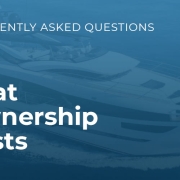
Yachting Consultants
Sale-Charter-Brokerage-Management
Headquarters:
34 Rue Caffarelli 06000 Nice, France
Front Office:
Boulevard de La Croisette – Port Canto 06400 Cannes, France
T.: +33 493 43 82 83 Email: [email protected] Website: www.alliedyachting.com


Boating Life
Boat classes explained.
A boat’s class is defined by its length, which is measured along the center line, from the tip of the bow to the stern, not including platforms, outboard motors, attachments, or anything that is not part of the actual hull. The class of a boat governs the safety requirements set forth by federal and state law. These requirements are regulated by the U.S. Coast Guard.
Boat Class vs. Boat Category
As we’ve mentioned, boat class is determined by length and is strictly related to the safety guidelines set forth by law. Boat category, on the other hand, is the type of boat as defined by manufacturers; categories such as bay boat, center console, deck boat, skiff, etc.
The 4 Boat Classes
Boats are divided into 4 classes: Class A, Class I, Class II and Class III. The only feature used to appoint a boat’s class is its length.
A Class A boat is any boat whose total length is under 16 feet.
Types of Boats
Boats that meet this classification include:
- Canoes/Kayaks
- Small Fishing Boats
- Inflatable Boats
- Personal Watercraft
Safety Rules & Regulations
It is not required to have day signals on board Class A boats, but it is required to have visual distress signals on board when operating at night. The signal must have been made within the last 42 months. A sound device such as a whistle or horn must also be present at all times.
The vessel must have at least one U.S. Coast Guard approved, Type I, II, III or V personal floatation device per person aboard. These must fit all persons properly, including children, and should be easily accessible. It is recommended that everyone wear their flotation device at all times, but the requirement is only that it is within reach of the individual that will be wearing it.
All of the above requirements are the same for canoes and kayaks. For all Class A vessels other than canoes and kayaks, the following requirements apply.
These boats must have a B-I fire extinguisher if it has a permanent fuel tank, enclosed engine, or enclosed living space. Vessels with enclosed engines are required to have U.S. Coast Guard approved ventilation systems, and for boats with gasoline-powered engines, excluding outboard motors, a backfire flame arrestor must be on board. Lastly, if there is an installed toilet, the boat must be equipped with a Type I, II, or III Marine Sanitation device.
A Class I boat is any boat whose total length is between 16 and 26 feet.
- Tow Sports Boats
- Aluminum Fishing Boats
- Small Deck Boats
- Cuddy Cabin Boats
- Wakeboard Boats
Safety Rules & Regulations
It is required to have a minimum of three day and night use flares signals on board Class I boats. You are allowed one non-flare signal substitute each for day and night. The day signal must be an orange distress flag and the acceptable substitute at night is an electric SOS light. These signals, including the flares, must have been made within the last 42 months. A sound device such as a whistle or horn must also be present at all times.
The vessel must have at least one U.S. Coast Guard approved, Type I, II, III or V personal floatation device per person aboard, as well as a throwable Type IV device. These must fit all persons properly, including children, and should be easily accessible. It is recommended that everyone wear their flotation device at all times, but the requirement is only that it is within reach of the individual that will be wearing it.
A Class II boat is any boat whose total length is between 26 and 40 feet.
- Cabin Cruisers
- Small Sail Boats
It is required to have a minimum of three day and night use flares signals on board Class II boats. Three combination day/night signals are acceptable. You are allowed one non-flare signal substitute each for day and night. The day signal must be an orange distress flag and the acceptable substitute at night is an electric SOS light. These signals, including the flares, must have been made within the last 42 months. A sound device such as a whistle or horn must also be present at all times.
These boats must have either one (1) B-II or two (2) B-I fire extinguishers on board. Vessels with enclosed engines are required to have U.S. Coast Guard approved ventilation systems, and for boats with gasoline-powered engines, excluding outboard motors, a backfire flame arrestor must be on board. If there is an installed toilet, the boat must be equipped with a Type I, II, or III Marine Sanitation device.
A vessel this size must also have a 5” x 8” Oil Discharge placard and a 4” x 9” Waste Discharge placard.
A Class III boat is any boat whose total length is between 40 and 65 feet.
- Sport Fishers
It is required to have a minimum of three day and night use flares signals on board Class III boats. Three combination day/night signals are acceptable. You are allowed one non-flare signal substitute each for day and night. The day signal must be an orange distress flag and the acceptable substitute at night is an electric SOS light. These signals, including the flares, must have been made within the last 42 months. A sound device such as a whistle or horn must also be present at all times.
These boats must have either one (1) B-II and one (1) B-I or three (3) B-I fire extinguishers on board. Vessels with enclosed engines are required to have U.S. Coast Guard approved ventilation systems, and for boats with gasoline-powered engines, excluding outboard motors, a backfire flame arrestor must be on board. If there is an installed toilet, the boat must be equipped with a Type I, II, or III Marine Sanitation device.
A vessel this size must also have a 5” x 8” Oil Discharge placard and a 4” x 9” Waste Discharge placard. If there is a galley, a waste management plan is required as well.
With boats this size, it is required to have Inland Navigation Rules aboard.
Bonus Class: Boats Over 65 Feet
Although boats over 65 feet in length do not have a class as it relates to personal use boats, they are subject to regulations. The vessel must have at least one U.S. Coast Guard approved, Type I, II, III or V personal floatation device per person aboard, as well as a throwable Type IV device. These must fit all persons properly, including children, and should be easily accessible. It is recommended that everyone wear their flotation device at all times, but the requirement is only that it is within reach of the individual that will be wearing it.
The fire extinguisher regulations for a vessel of this size are based on weight. These boats must have one (1) B-II fire extinguisher if the boat weighs up to 50 gross tons or two (2) B-II extinguishers if it is over 50 tons. These vessels are required to have U.S. Coast Guard approved ventilation systems, and a backfire flame arrestor. A Type II or III Marine Sanitation device is required.
Final Words
When you purchase or are aboard any boat, it is important to know its class so you can verify it meets all safety guidelines. In case of emergency, being down even one floatation device, sound signal or flare could completely change a situation. It is always recommended that passengers abide by safety requirement and precautions while on the water. Everyone here at Ingman Marine wishes you a happy and SAFE boating season!
Happy Boating!

Dealership Headquarters

IMAGES
VIDEO
COMMENTS
Class Certificate: This mainly deals with the yacht's hull, machinery, electrical equipment and outfitting. International Load Line Certificate : This certifies the weather-tightness of the yacht. Safety Radio Certificate : This is applicable if gross tonnage exceeds 300GT This concerns the radio communication and distress installations.
A Class D boat is built for protected or sheltered waters such as canals, rivers, small lakes and sustain a force 4 and waves UP TO .3 meters (less that 1 ft). With this said, you can understand that the Class A yacht ( boat ) respects a rigorous building code more so than a Class B and so forth.
Classes of boats and types of boats are two different things. Every type of boat fits into one of four classes of boats. While a type of boat can vary significantly in appearance and function, class is easy to understand. Boat classes are all determined by the overall length of the vessel. The class of a boat is significant for you as a boat owner.
Class 3: Boats measuring between 40 and 65 feet. This class includes yachts, sport fishers, catamarans, sail boats and go-fast boats. To operate this class of boat safely, you need to have: One approved Type I, II or III personal flotation device (PFD) for each person on board or being towed on water skis, etc. and one throwable Type IV device;
Class 3. Boats measuring more than 40 feet but less than 65 feet. How To Determine a Boat's Size. To find out a boat's length, measure along its center line from the outside of the bow to the outside of the stern. That means any attachments, such as swim platforms or wakeboard towers, don't count towards its length. ...
Class 3 Boats: 40- Less Than 65 Feet. The largest category, Class 3 boats, vary in size from 40 to 65 feet in length. Safety equipment requirements demand that Class 3 boats owners have the following onboard: a Type II or Type III marine sanitation device, a horn or whistle, and three-day use and three-night-use signals.
Better Boat: The ABCs of Classification Owners moving from smaller yachts into those over roughly 80 feet will quickly learn a new alphabet: ABS, DNV, BV, LR, RINA, and more. These are organizations that set rules governing the construction, maintenance, and operation of yachts.
A yacht that has been designed and built to the appropriate Rules of a Society may apply for a Certificate of Class from that Society or for a periodical survey (generally required every 5 years) meant for the Renewal of Class Certificate. Class Societies have often developed two separate sets of Rules for Commercial and Private Yachts.
A Class III boat is any boat whose total length is between 40 and 65 feet. Types of Boats. Boats that meet this classification include: Sail Boats; Sport Fishers; Yachts; Catamarans; Safety Rules & Regulations. It is required to have a minimum of three day and night use flares signals on board Class III boats. Three combination day/night ...
Class 3 is the largest of the types of land yacht sailed in the UK. It is a development class that has evolved from the pole-masted yachts, which predominated in the 1960's. All land yachts use 'lift' generated on the wing shaped sail to travel at between 3 and 5 times the wind speed reaching speeds in excess of 60 mph.